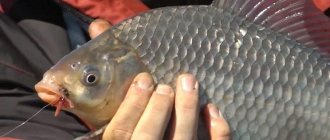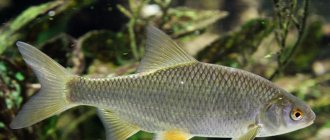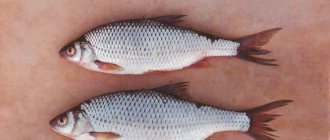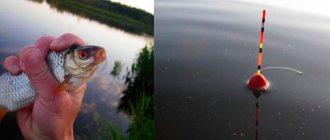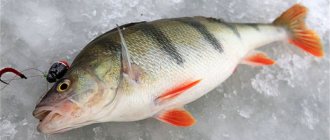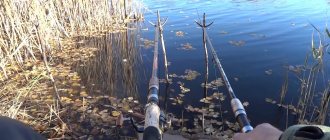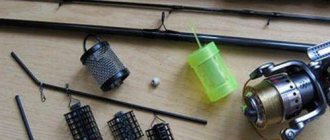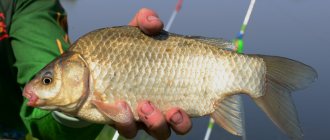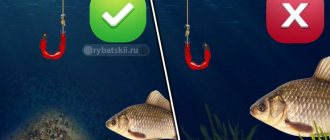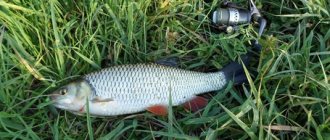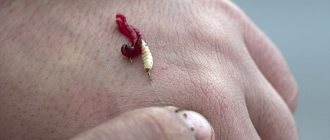Catching roach on a feeder is interesting and relevant for most novice feeder anglers. Moreover, it’s spring now; this beautiful fish is most active at this time.
Let's start with the appearance of this agile fish. The roach has a short body length, but in some reservoirs and locations you can run into a decent bonus. More often found in catches from 10 to 40 centimeters. Various sources indicate the maximum size of caught roach to be 71 centimeters. The scales of roaches are not small; they greatly depend on the size of the fish. Roaches have bright orange, reddish eyes .
Novice fishermen often confuse this fish with rudd, but this should not be done. I think fish should be known, especially since they are not some kind of exotic fish.
Where does it live?
Roach is very common and is found everywhere. I caught it both in still water and in large rivers. Loves plenty of oxygen and shallow depths. The depth is only necessary for wintering. I haven’t caught large roaches in stagnant bodies of water; they are mostly small in ponds, lakes, and reservoirs. Although once I got to the distribution of “loaves” on the Yauza. Large specimens are found in the river much more often.
It was not possible to catch very large specimens, but roaches weighing 400–500 grams were caught. I fish in the Kaluga and Tula regions. You can catch good roach in the Kaluga region on the rivers: Oka, Zhizdra, Ugra, Protva, Zhelov. From standing reservoirs, I would look at: Lake Rezvan, Andreevsky quarry, Lake Vyrka, also sometimes found on the Yachensky reservoir, but not in large quantities. In the Tula region, I caught roach only on the Upa River and Lake Goryachka. The Upa is an interesting river, a lot of fish and its size is sometimes amazing, it’s a pity that I can’t go there as often as I want, but my native Oka is enough.
Tackle
First of all, let's start with the selection of gear, taking into account all the features of roach fishing.
Rod
Catching roach on a feeder rarely requires long casting - the fishing distance does not exceed 50 meters. In addition, roach is small in size, so you don’t need heavy-duty gear to catch it.
Basically this is a plug rod consisting of 3-4 connections. Feeder rods have replaceable tips that differ in their rigidity. To catch roach, choose the most flexible and sensitive tip.
The characteristics of the rod depend on the characteristics of the reservoir.
- For fishing in still water, we take a rod 3.5-3.8 meters long, with a test weight of up to 80-90 grams.
- For fishing in the current, given that you will need a heavier feeder, the rod weight should be from 100 to 120 grams.
- For fishing at short distances - up to 20-30 meters, which often happens in small and medium-sized reservoirs, a picker up to 3.5 meters long and a weight of up to 50 grams is enough.
Speaking about certain manufacturers, pay attention to Mikado Twin Feeder, Salmo Taifun, a high-quality line of feeders from the manufacturer Shimano, Daiwa, Preston. Good budget domestic options.
Coil
Considering that the fishing takes place at a short distance, a large reel is not needed - a size of 2500-3000 is quite sufficient. Roach is not a fish that will actively resist when fished, so a power reel is not needed. Here, high rewinding speed will be more important.
For fishing in strong currents, take larger reels 3000-3500.
Line and leashes
For fishing in still waters at short distances, a mono line with a diameter of 0.16-0.18 mm is used. For medium and long distances, braided wire with a diameter of 0.12-0.14 mm is preferable.
If you are using braid, the reel should have a metal spool.
For leashes, monofilament fishing line is used, with a diameter of 0.02-0.04 mm less than the main one.
Roach is a very cautious fish, so leashes made of fluorocarbon fishing line, which are less noticeable in the water, are a good option.
The length of the leashes is adjustable depending on the intensity of the bite. Initially, leashes of shorter length are placed - if there are no bites, then the length of the leashes is increased.
Hooks
You will need thin hooks; the length of the shank is selected depending on the type of bait. The size of hooks is 15-18 numbers according to the international classification. In cases where you expect to catch a large roach, use large bait and hooks of 12-14 sizes.
Feeders
We select feeders depending on the current. For standing water, a mesh type or method is better.
For fishing in the current, it is advisable to use closed metal feeders.
For long casts, feeders that are weighted at the bottom and have good flight properties are suitable.
Equipment
When choosing the type of equipment for catching roach with a feeder, keep in mind that the roach will not move the feeder from its place, so self-hooking options are not suitable. The tip of the rod should be sensitive and respond promptly to a bite.
The following equipment is used:
- Paternoster (Gardner's Loop)
- Sliding equipment
Many anglers use a Gardner loop because this type of installation is particularly sensitive. It is suitable for fishing in silted waters. Even if the feeder is immersed in silt, this will in no way affect the reaction to the bite.
The good thing about sliding equipment is that it is easy to install and eliminates the resistance of the feeder at the moment of biting.
Rod selection
Let's talk about feeder rods for catching roach. Let's divide our fishing into two types, take into account fishing on the river and fishing on a standing reservoir separately. On a large river you will need a feeder rod with a test rod suitable for the strength of the current. The height of the rod is selected individually, a rod with a height of 3.6 meters will be universal, for long casts it is worth looking at a feeder with a height of 3.9 meters. It is not always worth looking for roach on a strong current; I have had cases when I caught this red-eyed fish right under the shore on a large river, then I actively used gear for standing reservoirs, because the current was minimal or completely absent.
For lakes and ponds, you will need more delicate rods. I prefer to use picker rods. I get maximum pleasure from such fishing, especially when roach is actively caught. When fishing with picker rods, there is one difficulty. Due to the small size of the feeder, casting further than 30 meters is problematic. Here you will need a Medium class “stick” for fishing at medium distances, for example, up to 50 meters. On reservoirs, you sometimes have to use long-range sticks to fish at long ranges. You won’t guess where this nimble fish is at the moment.
What bait to use for catching roach
Since I very often catch roach in the current, on the Don River, I use a special composition of bait, which has proven itself in more than one fishing trip.
The composition includes the following ingredients:
Marseille bait mixture;
Some breadcrumbs;
Priming;
Flavoring, also marseille;
And about 100 grams of live bait (bloodworms or maggots).
The bait should be mixed directly on the pond, first mix the soil and the bait mixture, then sift the resulting consistency through a sieve, separating the bait from the lumps. Gradually add water and live bait.
We add flavoring last, I use liquid, it is most effective. The bait should not be very dense and not very loose. Try to find a middle ground, then the number of trophies will increase!
You need to remember one important detail: you shouldn’t overdo it with the attractant, otherwise the result will be the opposite. Instead of attracting fish, we scare them away and then our fishing will end.
After the bait is mixed, we begin to feed the point. We make 3 - 6 casts of the feeder, then let the point rest for 10 minutes, and only then we start fishing.
During the fishing process, the bait can be reduced in volume, because no one wants to overfeed the fish either. With this, we’ll finish our conversation about bait and move on to baits.
Feeder equipment for roach
Often you have to catch roach in competitive mode. Therefore, my favorite feeder rig is “Running Feeder Rig” or “Inline”. These are two almost identical installations, their essence lies in the safe “exit” of the fish if the entire installation breaks at once, in case of emergency. The installation is sliding and gives good sensitivity and delicacy to the gear. When using any installation, I recommend installing an outlet under the feeder and a leash. An outlet made of fluorocarbon or thicker fishing line is suitable for the feeder. For retraction under the leash, when fishing with thin leashes, you should think about an insert made of beaded rubber and feedergam.
I can also offer another option for installing feeder gear, the long-loved Paternoster. Thanks to the right large loop, it will be possible to slightly retain the bait in the thickness or bottom layer, which increases the chance of catching this beast, if, of course, roach is present at the point and does not behave passively. Paternoster installation is simple and it’s easy to tie it directly on a pond, the main thing is to practice.
Catching roach on a feeder in spring, summer and autumn (behavioral features)
| Spring | Summer | Autumn |
| In spring, roaches begin to peck shortly before spawning and go through this period within 3-4 days. It is quite difficult to get into the roach feeding period in early spring. It happens in mid-May. After which the roach begins to actively spawn and there may not be a good bite until the beginning of June. The best spring baits: bloodworms, worms, maggots. The best bait is with the addition of bloodworms. In March and April, it is very difficult to catch roach on a feeder, at least in the central region of Russia, where at that time there is either ice or the ice has just melted. You need to look for spring roach at depth. | Summer roach fishing is quite active and even throughout all three months: June, July and August. The best baits will be vegetable baits: corn, green peas, dough + worm, maggot. In summer, roaches often come to much smaller places than in spring and autumn. | In autumn in September you can continue to actively catch roach, but the closer it gets to cold weather, the worse the bite will be. And even fishing at depth does not always save the situation. Use cold water bait with the addition of chopped worms and bloodworms. Use worms, bloodworms, and maggots as bait for roaches in the fall. |
Cord or fishing line
The choice between cord and monofilament line as a base. The issue is controversial and ambiguous, so I’ll tell you what I think about it. I often use monofilament line as a base, but it is only good for fishing at short distances of 15–20 meters. Due to the stretchability, the bites come with a slight delay and you can miss the moment of hooking, but if you get used to it, it won’t hurt you at all. I love fishing with a fishing line, at first it was uneasy, but then everything fell into place. If we are talking about distant frontiers, then we choose a braided cord. We conclude that when fishing for roach, there is no preference in the main material of fishing line or cord, with the exception of fishing distance.
If you are going to fish with a fishing line, choose a feeder line rather than a regular one. The feeder line stretches less and will be relevant when catching any fish. An ordinary monofilament line will be relevant only when fishing for carp, often for large specimens. I recommend a black feeder line - Dunaev Feeder Match.
Choosing a place to catch roach
Since feeder gear is based on the principle of initially baiting fish, a place for fishing must be chosen in an area with a strong river current.
The flow of water will spread the bait over a fairly large area of the reservoir, gathering schools of roach in one place. Attention! Feeder gear for roach works well at a depth of at least 2.5-3 meters. When casting gear into shallow water, the impact of the feeder on the water can scare away the fish.
Photo 1. Dam's place.
A place for catching roach in the fall on a feeder must be chosen after thoroughly studying the bottom topography. To do this, you can use one of two common methods of measuring depth: a marker float or a jig probe.
Marker float
When using this method of studying the bottom, one should take into account the fact that the data may have errors in places where the river current is strong. The principle of measurement is quite simple: equipment with a marker float is attached instead of a feeder, and is thrown into the areas of the expected lowland. As soon as you feel that the float and sinker have gone to the very bottom, make a mark on the line and begin to slowly pull it up. Make the second mark at the moment when the float appears above the water. The length of the fishing line between the two marks will indicate the depth of the river in this area.
The marker float is suitable for studying the bottom topography, both from a boat and from the shore, and provides fairly accurate information.
Jig probing
To measure the depth of a reservoir using this method, you need a heavy (at least 20-25 grams) sinker and a strong fishing rod with thick fishing line. Be prepared for the fact that during a long cast you will need to do some analysis by comparing the results of your research.
Try to throw heavy tackle deep into the reservoir. As soon as the sinker sank to the bottom and the line sagged slightly, make 3-4 turns with the reel, pulling the rig towards the shore. At the moment of stopping, start a second-by-second countdown until the load is immersed again. This needs to be done several times, and then compare the time and determine in which place the tackle took longer to sink to the bottom.
Unfortunately, the jig probing method has some error and cannot always serve as a basis for accurately determining the deep hole.
What kind of leash should I use?
Let's look at the selection of leashes for roach fishing. The leash plays an important role in this fishing. The roach usually stands in the bottom layer, which means that you need to make a smooth animation of the bait as it falls. It is precisely at this moment that the roach attacks in its active state. Unfortunately, this does not always happen; fish can also actively feed from the bottom. There is no clear idea of where the fish are currently feeding. Check this point during the fishing process, experiment with the leash and hook for the feeder.
I think when fishing for roach, a light hook is important, and it’s also worth choosing a combination of bait to ensure good results.
Start fishing with a meter-long leader made of thin-diameter fishing line, and then you will see. It may be worth lengthening or, conversely, shortening the leash for indistinct poking and sucking of the bait. When fishing for roach on the feeder, I use Owner 53101 hooks in numbers 18.16; these hooks have a red coating, which makes the bait stand out. The fishing line is suitable in diameters from 0.07 to 0.12 mm, depending on the activity and size of this red-eyed fish.
Read more about how to choose a hook number for a roach.
Feeder equipment
As in any other feeder fishing, the rod and reel are selected depending on the fishing conditions. Roach can be caught on heavy river feeders far from the shore, and on mediums at medium-long distances, with or without lighter feeders on medium (small) currents. At close range, of course, it is better to use pickers - their sensitive tips are an excellent help in the fight against cautious bites.
Accordingly, feeder feeders are selected by weight depending on the strength of the current, the required casting distance and the test of the rod. Feeder gear for roach in the current needs to be as light as possible that can ensure casting and stability of the feeder at the bottom. We put a spool with thin braid on the reel (for long casting we also put a shock leader), even if the fishing takes place at close range. The thin braid holds the current well and transmits weak, careful bites. Sometimes indiscriminate bites on monofilament are transmitted even worse. We use monofilament in winter, early spring or late autumn at sub-zero temperatures as a measure against freezing. In such conditions, the braid becomes tanned and gets stuck in the rings of the feeder rod. Read more about assembling feeder gear.
Working installations
Any classic rigs work for roach on a feeder, and even the flat method on lakes or ponds if the hook and bait are small. There is no best feeder installation - they all work worse or better in the hands of different anglers and fishing conditions. We use the usual feeder installations that we always work with - paternoster, Gardner loop, symmetrical or asymmetrical loop, inline (Running Feeder), helicopter and two knots. All this is suitable for standard bottom fishing.
However, as already mentioned, sometimes the roach prefers to take a slowly falling bait. In such conditions, it is better to use equipment for catching roach in the form of a helicopter and two units. In this feeder rig there is no twisting or thick bend, which weigh down the part of the leash closest to the main line. In addition, the leash used is thin and long - sometimes up to 3 meters, with a light hook and attachment. In the current, such a bait can fall to the bottom after casting for 5-7 minutes, which is usually enough for a bite. Article about installing a helicopter for a feeder:
https://rybafan.ru/fiderist/osnashhenie/osnastka-vertolet-dlya-fidera
Helicopter
If we fish on a difficult bottom - with shells, stones or because of a sharp edge - it is better to make rigs and shocks based on fluorocarbon. This fluorocarbon line has the best abrasion resistance characteristics.
Hooks and leashes
Usually, leashes of 0.1-0.12 mm are placed on roaches. For a large ram during the spring run in muddy water – thicker, 0.14-0.16 mm. In clean cold water, sometimes it is necessary to use 0.08 mm webs. Due to such thin diameters, increased demands are placed on the quality of the leader material, and the base on the feeder is an inextensible braid.
A roach weighing 200 grams, if fished inappropriately, can break such a thin leash, but in addition to it, bream and crucian carp of a kilogram or two can fly onto the feeder. Therefore, we do not make sharp cuts; we pull carefully, using the adjusted reel clutch. Additionally, you can protect the thin leash from breaking by placing a spacer made of feeder rubber - feedergam - between it and the outlet. The feedergam insert can be installed on almost any feeder installation. It is important to choose the correct length and tensile strength.
How to tie a hook
Hooks for catching roach on the feeder are small and sharp, catching at the slightest attempt to attack the bait. Therefore, it is better to use reputable brands - Owner, Gamakatsu and the like. The size itself is selected for the bait, usually 16-18 for bloodworms and 14-12 for a large sorog or ram, for a bouquet of maggots, a bunch of worms or corn.
Sometimes, especially in clear water, the color of the hook also matters. At one time, a shiny hook can scare away, at another, on the contrary, it can attract fish. Therefore, different colors are in use: black, red and gold. In this matter, as with baits, you need to experiment directly on the pond.
Feeders
I would recommend feeders with a small feed capacity, but you shouldn’t stay too long at the point. Thimbles are perfect for catching small roach. Keep throwing it around and the fish will definitely come. Don’t shy away from various flavoring additives; I like dry additives from the French ones called “Gardons” or “Rotaugen”.
Bait and its combinations
When a roach is active, it takes everything it sees into its mouth. In warm water, any bait will be relevant: maggot, worm, bloodworm, pearl barley, wheat, corn. If we are talking about feeder fishing in early spring or late autumn, then pay more attention to bait of animal origin, and in particular, to bloodworms. Combinations of maggots + bloodworms, as well as bloodworms (in a stocking or ring, in the middle) help well.
When fishing with maggots, if the bite is bad, try cutting the butt of the white larva with scissors; an enzyme from the maggot will be released in the water, which makes it bite on the bait.
Barley and wheat will be relevant only in warm water, May - September. Or on warm reservoirs all year round, for example the Desnogorsk reservoir. When feeder fishing for roach on corn, bites will be less frequent, but the size of the fish will increase if there is a large roach at the point. All winter I successfully caught large roach on the Desnogorsk Reservoir, including using corn. An excellent reservoir, it helped me scratch the “winter itch” and have a blast with the most beautiful roach.
Nozzle and bait
As usual, one of the best baits for feeder fishing will be maggots. Fishing for roach is no exception here - perch and ruff will be caught more often with bloodworms, and their bites are not very desirable. It is better to plant 1-2 maggots at a time, bringing the hook tip out. The larger the maggot, the more appetizing it is, and the greater the chance of catching a trophy specimen. If you want to cut off small bites, attach a worm. The tail droop should be small. As a rule, small roaches are not very willing to take the worm.
Flavoring additives for carp bait
Spinner for burbot in winter
Preparing complementary food for carp at home
One of the best baits is a caddis larva. Since March, they have been swarming in coastal debris on river floods, even if there is still snow on the shore. Outwardly, they look a little like maggots, but they are gray in color. Over time, they climb into pieces of straw or build themselves “houses” out of garbage and crawl in them, but this is by the time they already have paws. The best bite is for larvae without legs. If you are not afraid to soak your hands in ice water, collect a couple of dozen larvae right next to the fishing spot. They will survive the rest of the fishing trip in a glass of water, and then they can be released back into the water.
There is no point in using plant attachments in the spring. If you fish without a feeder or want to cut off ruff bites, try a semolina mash. It will “gather dust” in the water during the current and is clearly visible in cloudy water. However, the bite on it in the spring will always be worse than on an animal bait. Moreover, if the roach is small, it will tear it apart quite quickly, and you won’t spot anyone. It makes sense to use it if you want to determine whether there are roaches in a given area or not by the presence of bites and the bait eaten.
For lovers of homemade porridges - without peas in the spring you will not catch anything. This is an obligatory component in spring bait, and the porridge should be prepared on the basis of pea puree, adding millet, rolled oats, and corn flakes. And – animal component.
Spring bait for catching roach in the current must necessarily contain animal components. Purchased food should be “protein”. During the current, it makes sense to use food with a strong aroma - in the spring, fish may come to the aroma. Suitable animal components include bloodworms, small maggots, and chopped worms. You can add a little soil to the bait so that it washes out as long as possible.
These animal ingredients are good if you have the money and can afford to buy enough of them. A more economical option for the animal component is dried daphnia. This is food for aquarium fish. The effect is even better than from food bloodworms, and they cost 20-25 rubles per 100 grams. Add them little by little to the bait when fishing, a pinch per feeder. 200-250 grams will be enough for you all day. It is more profitable to buy it in bulk at pet stores - they sell it there in kilograms, it will cost about 150 rubles per kilogram.
Bait and its role in catching roach
With feeder bait for roach it will be a little more difficult; you need to understand its meaning and the mechanics of its work. The roach loves it when the point is boiling, when there is movement there, when food particles float up and down. This attracts her from a distance. This doesn’t always happen; I’ve had fishing trips when roaches responded to inert and heavy food. Roach also becomes a frequent guest when fishing for other fish, but now we are only interested in targeted roach fishing.
Look at the packs with the name “Roach”. From aromatics, pay attention to sweet smells: Vanilla, Chocolate, Biscuit, Roach. Please note that I said about concentrates, do not confuse them with Aroma-Complexes. Concentrates do not change the mechanics of the feed, but only supplement and enrich it. Of the components in the form of an additive, use Copr-Molasses, this additive attracts roaches. Copra is coconut shavings soaked in molasses, a dizzying smell.
Also try adding a live component to the bait composition with plugs, namely feed bloodworms, maggots in different states of aggregation, and chopped corn. I also like the work of store-bought canned hemp, it’s a great thing, I add it in whole grains, and also sometimes cut it into porridge. The smell is just a bomb, all fish will appreciate it, including our beloved roach.
The main thing is to experiment, I have said many times that there is nothing exact in fishing. As they say, patience and work, and everything will definitely work out.
